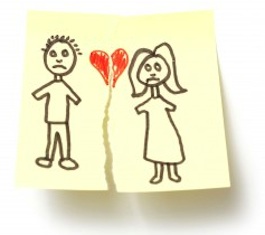The Treachery of Divorce
- LUMA SIMMS
The media continues to follow the divorce story of Angelina Jolie and Brad Pitt. The actress filed for divorce last September, stating that it was for the health of the family.
 She plans on seeking full custody of their six children. The fact that divorce can still make Hollywood news despite its commonplace occurrence in those circles reveals a truth which is experienced, even if unacknowledged and suppressed: marriage has a sacred dimension, the breaking of which has a violent effect on all persons involved. The Jolie-Pitt children are six out of about a million children a year experiencing the cruel consequences of divorce.
She plans on seeking full custody of their six children. The fact that divorce can still make Hollywood news despite its commonplace occurrence in those circles reveals a truth which is experienced, even if unacknowledged and suppressed: marriage has a sacred dimension, the breaking of which has a violent effect on all persons involved. The Jolie-Pitt children are six out of about a million children a year experiencing the cruel consequences of divorce.
I was married at 23, and I left the marriage shortly after our two-year anniversary. By then, I had a one-year-old daughter. My parents, Iraqi Christian immigrants, warned me: "Divorce is not the answer, it will only bring more hurt." They reminded me, "This is the American way, this is not our culture…Marriage is not primarily about your personal happiness…You have a responsibility…You took vows."
That advice was contrary to what I was given by counselors, friends, and acquaintances at the time. From them, I received what I would now describe as the cliché of the age: "If momma ain't happy, ain't nobody happy. You have to do what's best for you. You don't deserve this." Divorce was offered as a door to hope and happiness; an answer to my emotional and mental suffering. It was supposed to bring healing. Although I had read about what happens to children of divorced parents, I believed I could beat the statistics. I remember I used to confidently tell people: "I'm going to make sure that my child will not become another divorce statistic." But this decision, which I naively assumed would solve my problems, betrayed me. Divorce was treacherous.
You need not believe the oracle of Malachi which states, "'For I hate divorce,' says the Lord the God of Israel," to acknowledge its ruinous effects on families. Divorce is unsparing; it does not privilege the religious. Divorce is a universally human problem. The wounds are deep; the pain is real. Twenty-two years later, I still reap the results of foolish and shortsighted decisions. My wrongs are always before me.
Although I had read about what happens to children of divorced parents, I believed I could beat the statistics. But this decision, which I naively assumed would solve my problems, betrayed me.
I've been pleased that the divorce rate has recently dipped to a 40-year low, as shown in a recent study by the National Center for Family & Marriage Research (NCFMR). And in 2014, the divorce rate for first marriages was down to 15.7 divorces per 1,000 married women. The fact that there is such a term as "first divorce rate" in itself is disheartening (as the NCFMR notes, the divorce rate tends to be higher for remarriages).
Even before my divorce, I read the social science data and analysis of its effects. Twenty-two years after my divorce, I have gained a different perspective. The best essay I've seen on the subject is by IFS senior fellow W. Bradford Wilcox, a gem from the fall 2009 edition of National Affairs. As I read it, I can see my life and that of my child from the divorce. Wilcox touches on what I consider to be a fundamental issue, although he doesn't state it as such: at root, divorce is a philosophical shift. He writes:
Prior to the late 1960s, Americans were more likely to look at marriage and family through the prisms of duty, obligation, and sacrifice. A successful, happy home was one in which intimacy was an important good, but by no means the only one in view. A decent job, a well-maintained home, mutual spousal aid, child-rearing, and shared religious faith were seen almost universally as the goods that marriage and family life were intended to advance.
But the psychological revolution's focus on individual fulfillment and personal growth changed all that. Increasingly, marriage was seen as a vehicle for a self-oriented ethic of romance, intimacy, and fulfillment. In this new psychological approach to married life, one's primary obligation was not to one's family but to one's self; hence, marital success was defined not by successfully meeting obligations to one's spouse and children but by a strong sense of subjective happiness in marriage — usually to be found in and through an intense, emotional relationship with one's spouse. The 1970s marked the period when, for many Americans, a more institutional model of marriage gave way to the "soul-mate model" of marriage.
A person's philosophical view of happiness and suffering, obligation and sacrifice, is where it all begins. At the heart of many of our cultural woes, especially divorce, is our frenzied desire for happiness and the avoidance of pain and suffering. In contrast, the premise of my parents' advice to me many years ago was that suffering is not something to be avoided at all costs — one can learn to live through it. And happiness comes primarily from love and self-sacrifice, not by seeking the fulfillment of my personal desires.
Divorce seduces. During seasons of hardship, it looks to be a way out of our misery, but instead, bitterness never fails to follow.
It is at this basic philosophical level where we are betrayed. Marriage is hard work, and like most of life, it has the capacity for joy as well as pain. Divorce seduces. During seasons of hardship, it looks to be a way out of our misery, but instead, bitterness never fails to follow. My use of words such as "violent" and "treacherous" to describe divorce may seem inflated, but that is only because of our narrow and flattened understanding of these terms. For example, when we think of violence, we tend to think mainly of outward actions such as punching, kicking, shouting, or other hostile acts. The same is true of "treachery," and the ideas the term embodies, such as betrayal and unfaithfulness, which are mostly a cause for entertainment in our Jerry Springer culture. In truth, that primary movement within my very being where I shift from thinking about what is good for the other, to what is good for me, is the foundational act of violence and betrayal. The other could be a spouse, a child, a friend, a neighbor, and so on. And those thoughts that eventually become outward acts can span the gamut from eating the last apple without considering anyone else in the house, to the death of a child's family through divorce.
Divorce — which terminates a bond between not only husband and wife but their children as well — is violent by nature because it ends the familial — or shared — life of that particular group of people. This idea may not make sense to someone who has a singular view of the human person — where the individual exists for him or herself, and it is up to each one to determine what is good for him or her. But as some people who have gone through a divorce can tell you, it often feels like grief after a death — if not to the person who leaves the marriage, then certainly to the spouse who is left behind and definitely to their children. And that's because it is. No one experiences this more acutely than the children of divorce. And some of them never recover. As Wilcox says in his essay, The Evolution of Divorce, there was a time when people believed that "divorce could leave an indelible emotional scar on children, and would also harm their social and economic future." Could it be that this view is correct after all? I think the social science data bears it out (see here and here and here, for example).
Two things are important to acknowledge: First, there are marriages that are truly dangerous to the health of one or more of the persons involved. Divorce may very well be necessary in some cases, but as Wilcox mentions in his essay, those are not the norm. Second, my intention is not to be a prophet of doom: I am not saying there is never hope after divorce or that there is no healing whatsoever. There is. I remarried two years after I left my first marriage. This coming June, we will celebrate our 20 year anniversary, and we have a good marriage. Nonetheless, we carry with us the wounds of the past. Even when some of those wounds heal, there will always be scars.
Divorce will always be with us because human weakness will always plague us. The goal for us as a society is three-fold: First, continue to drive down the divorce rate according to some of the policy changes featured on this blog. Second, showcase the beauty of marriage in the culture. This includes stories, movies, music and so on — cultural engagement that captures the imagination. Third, address the philosophical issues at the heart of our human weakness, as discussed above. Just because we can't have a perfect world does not mean we cannot attempt and indeed achieve a better world where fewer marriages end in divorce — a society that works for our common good.
 This is Meaghen Gonzalez, Editor of CERC. I hope you appreciated this piece. We curate these articles especially for believers like you.
This is Meaghen Gonzalez, Editor of CERC. I hope you appreciated this piece. We curate these articles especially for believers like you.
Please show your appreciation by making a $3 donation. CERC is entirely reader supported.

Acknowledgement
 Luma Simms. "The Treachery of Divorce." Institute for Family Studies (January 17, 2017).
Luma Simms. "The Treachery of Divorce." Institute for Family Studies (January 17, 2017).
Reprinted with permission of the Institute for Family Studies.
The Author
 Luma Simms is an Associate Fellow at The Philos Project. Her essays and articles have appeared in First Things, Public Discourse, The Federalist, Institute for Family Studies, and other publications. She studied law at Chapman University School of Law before leaving to become a stay-at-home mom. At Chapman Law, she worked for The Claremont Institute's Center for Constitutional Jurisprudence as a research assistant to Dr. John Eastman. Mrs. Simms was born in Baghdad, Iraq, her parents and ancestors are from Mosul, and she speaks Arabic with a Moslawi dialect. Her greatest loves are theology and political philosophy. She is the author of Gospel Amnesia: Forgetting the Goodness of the News.
Luma Simms is an Associate Fellow at The Philos Project. Her essays and articles have appeared in First Things, Public Discourse, The Federalist, Institute for Family Studies, and other publications. She studied law at Chapman University School of Law before leaving to become a stay-at-home mom. At Chapman Law, she worked for The Claremont Institute's Center for Constitutional Jurisprudence as a research assistant to Dr. John Eastman. Mrs. Simms was born in Baghdad, Iraq, her parents and ancestors are from Mosul, and she speaks Arabic with a Moslawi dialect. Her greatest loves are theology and political philosophy. She is the author of Gospel Amnesia: Forgetting the Goodness of the News.




